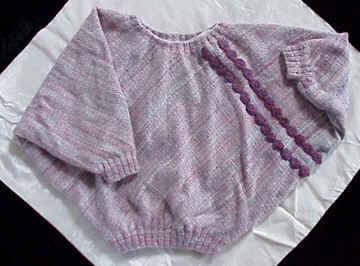
The polwarth (sample P7) was obtained from Wendy Dennis in Australia. Her fleeces are superb, coated all year, always lustrous, strong and clean. first I washed the white fleece and separated it into three equal amounts. One portion was left natural and allowed to dry in a sunny window on a towel. One portion was dyed with textile resources acid dyes in magenta shades and the last portion in lavender shades (sample P5). the dyes were carefully mixed to mimic the colors achieved by logwood with alum mordant and brazilwood with alum and copper mordants. No care was taken to get even dyeing. Half of each color was put aside for the body of the sweater.
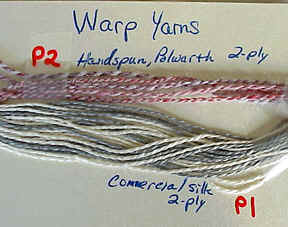 |
The other half of the magenta and lavender were carded twice through on the drum carder. after being pulled into a worsted roving they were spun Z twist on a double drive flyer wheel, ratio 19:1. Extra twist was added. Because of my earlier discoveries, I planned to use a three ply. for ease of achieving a consistent ply, I decided to Navajo ply the yarn. I did the plying on a double drive flyer wheel, ration 12:1 for control. I was very pleased with the resulting cord. Very strong, round, lustrous and hard enough to define the knots (sample P6). After removing the finished yarn from the bobbin I steam set the yarn in a commercial steamer for 8 hours. This set the twist in the yarn and finished the dyeing process so there would never by any bleeding.
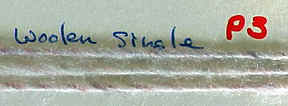 |
To spin the warp threads, I pulled
the batts into a worsted roving. These I spun on a double drive flyer wheel,
ratio 19:1. they were plied on the same wheel and given a balanced twist. the
diameter of the single was about the size of the fiber crimp near the diameter of the silk
thread. I processed the warp thread no further before warping
(sample P2).
The batts that were used for weft were tightly rolled into
enormous rolags and then pulled into woolen roving. The weft threads were spun
softly in an English Long Draw (sample P3). Because it was necessary to care for a
sick family member about an hour from home each day, I spun the woolen on a portable flyer
wheel, scotch brake with a ratio of 6:1.
The fabric looked nice when I removed it from the loom but still too sleazy for use. I washed it in Ivory Liquid, drained the excess moisture out and hung it out down the center of its length. When is was just about dry I put it in the fluff cycle of the dryer to full it. To finish the fabric completely I blocked it out and rolled it on a tube and steam set it in the commercial steamer for six hours. The final fabric had a nice hand and drape for a sweater and was homogenous in texture and color for the planned project.
 |
This sweater pattern can be finished in many different ways. My favorite finish is with knitted cuffs, waist band and neckline. From the remaining blended bats, I core spun over elastic to make an elastic yarn the same diameter as the weft yarn (sample P4). After sewing the basic sweater pieces together, I pulled loops of the elastic yarn up through the fabric where I wanted the ribbings and slid them on circular knitting needles. Using a 2 by 2 rib, I knitted twenty rows for the cuffs, ten rows for the neck, and twenty rows for the waist.
From my previous experiment with knots, I knew that soft flat knots were best suited for placing on garments. Medallion knots were too complex and would detract from the overall beauty of the fabric. But complicated medallions are excellent for adornment on smooth fabric such as velvet, suede or smooth linen. The double coin knots were simple, pliable and acceptable when made from a softer cord (sample P8). Using both colors of wool together in the knot allowed for more definition in the knot. A row of double coin knots can be manipulated into different shapes if desired. They make nice hearts and swirls. I chose to keep this design simple and followed the angles of the sweater with stripes.
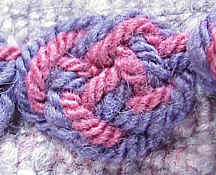 |
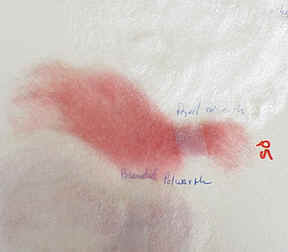 |
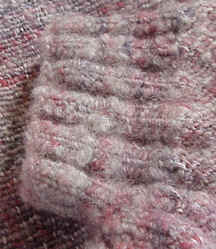 |
Detail of Elastic Cuff ![]()